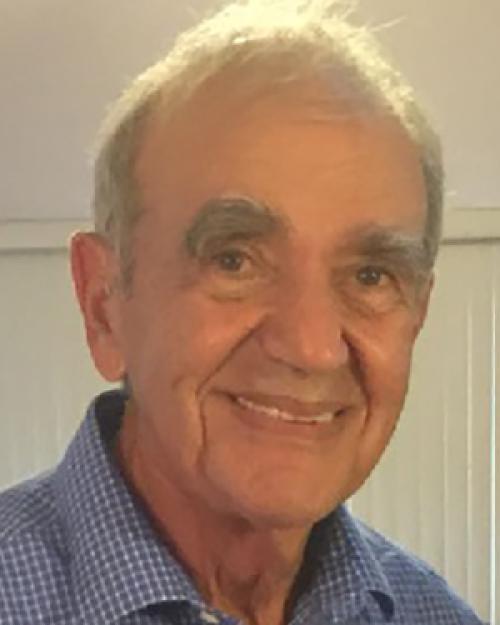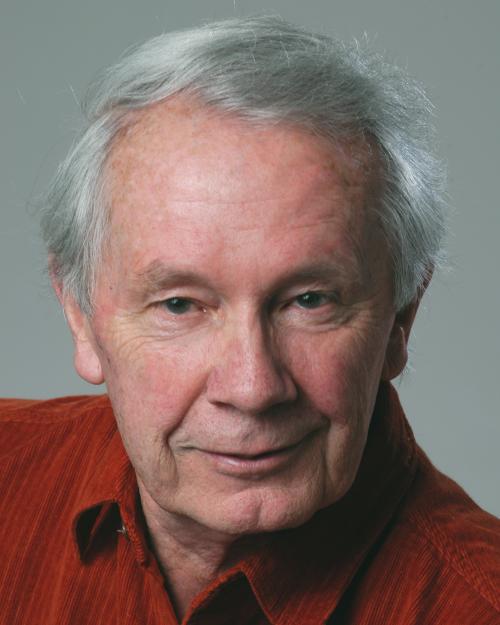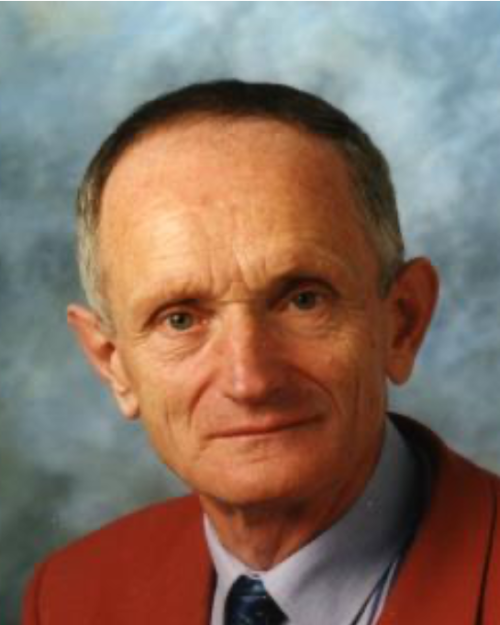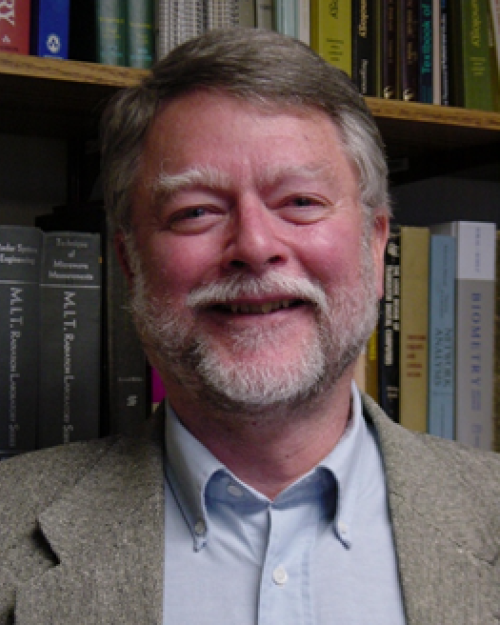-

Ekhard Karl Hermann Salje, FRS
-It is with immense sadness that we announce the passing of Professor Ekhard Salje, a distinguished member of our community and former President of Clare Hall (2001-2008). Professor Salje’s contributions to the field of Earth Sciences and his dedicated service to Clare Hall have left an indelible mark on both the College and the wider University.
Ekhard Karl Hermann Salje FRS was born 1946 in Germany. He was an Emeritus Professor and formerly Professor of Mineralogy and Petrology and Head of the Department of Earth Sciences at the University of Cambridge.
Most unusually he was a Fellow of the National Academies of 3 countries: United Kingdom – the Royal Society; Germany – the Leopoldina; Spain/Catalonia – Academia Royal. He was Chevalier dans l’ordre des Palmes Academiques (France) and was awarded the Cross of the Order of Merit of the Federal Republic of Germany in 2007, the highest order for a civilian. The People’s Republic of China presented him with China’s highest civilian honour, the Friendship Medal, at a ceremony in the President’s Lodge on 13th December last year, a great honour for the College. He held a senior visiting post at Xi’an Jiaotong University for many years and their President and a number of senior colleagues attended the ceremony with senior diplomats.
He was Head of Department in Hanover before he moved in 1985 to Cambridge. In 1998 he assumed the post of Head of Department of Earth Sciences which he retained for 10 years until October 2008. In October 2001 he became President of Clare Hall, a post he held until 2008. He set a very high bar for future presidents. He very much relished his time in Clare Hall and remained an Honorary Fellow there. He encouraged international cooperation at Clare Hall, in particular with China.
He ran several international cooperations. As Programme Director of the Cambridge-MIT Institute, he was responsible for joint research in the field of Future Technologies at MIT and in Cambridge. He was chairman of the highly successful Cambridge e-science Centre and chairman of the steering committee of the Cambridge Environmental Initiative (CEI) together with MIT. He was President of the British branch of the Alexander von Humboldt Association, Chairman of the Cambridge European Trust and a member of the Wissenschaftsrat (Germany), advising the Chancellor of Germany, Angela Merkel, on the future development of universities in Germany.
During visits abroad, he held the Mombusho chair in Japan, a visiting chair for Mathematics in the Sciences in Leipzig and chairs in Earth Sciences at universities in Bilbao, Grenoble, Le Mans, and the Université Paris VI. He was the Ulam fellow at the Los Alamos National Laboratory.
Professor Salje was the most cited researcher in Mineralogy and built the field of Mineral Physics in Cambridge. He used approaches that combine theoretical and experimental methods, such as the stability of minerals and the transformation processes that occur within them in response to changes in temperature and pressure. He developed the field of ‘Ferroelasticity’ which plays a major role in minerals but also in metals and high-tech materials. The dynamics of phase transitions include the movements of nano-domains which progress as avalanches. Over the last decade, he cooperated on these topics with Professor Ding and members of his group in Xi’an.
Beyond his academic achievements, Professor Salje was a cherished member of our community, known for his warmth, generosity, and unwavering commitment to fostering academic excellence and collaboration. His leadership as President of Clare Hall was marked by significant advancements in our academic programmes and a deepened sense of community among Fellows and students, which continues with the annual award of the Salje Medal.
We extend our heartfelt condolences to Professor Salje’s family, friends, and colleagues. His legacy will continue to inspire scholars in Cambridge and around the world for generations to come.
Obituary from Cambridge University

Rattikorn Yimnirun
The IEEE Ultrasonics, Ferroelectrics, and Frequency Control Society (UFFC) mourns the passing of Professor Dr. Rattikorn Yimnirun, a dedicated researcher, educator, and member of the ferroelectrics community. Prof. Rattikorn passed away on February 9, 2025, in Thailand.
Prof. Rattikorn was an active member of IEEE, serving in leadership roles, including Past Chair of the IEEE Magnetics Society Thailand Chapter and Past Technical Program Chair of IEEE TENCON 2023, Thailand. He was also involved in the Ferroelectrics Committee of UFFC, contributing to the advancement of research and collaboration in the field.
Beyond his work with IEEE, Prof. Rattikorn was a long-standing member of the Editorial Board of the Chiang Mai Journal of Science. Over the past 20 years, he was a strong supporter of the journal, playing a key role in its growth and development. Prior to his latest appointment in 2017 as Professor of Materials Science at the Vidyasirimedhi Institute of Science and Technology (VISTEC), he held faculty positions at Chiang Mai University (2001-2009) and Suranaree University of Technology (2009-2017), advancing research in materials science.
Prof. Rattikorn was a valued mentor who encouraged and supported many students and colleagues. His kindness, guidance, and dedication to education and research will be remembered.
IEEE UFFC extend its sincere condolences to his family, friends, and colleagues on this great loss.

Moises Levy
-Moises was a highly recognized and admired physicist whose main scientific impact was in ultrasonic measurements of metals, alloys, and superconducting materials. He was born in Concepcion, Panama, on April 8, 1930. Following a family move to California, Levy attended UCLA for a year and then transferred to the California Institute of Technology (Caltech), where he received his BS. He was drafted into the US Army and returned to UCLA after that service, receiving his PhD in 1963. His thesis topic was “Superconducting Energy Gap of Ta, V, and Nb.” Following several post-docs, he obtained a tenured Professorship at the University of Wisconsin-Milwaukee. Moises continued studying ultrasonic properties in superconductors, including high-Tc superconductors, for decades. He was supported at UW-Milwaukee by Max Swerdlow of the Air Force Office of Scientific Research. Levy stayed at UW-Milwaukee for over 30 years, where he mentored over 20 graduate students and retired as Professor Emeritus in 1996.
Levy’s academic honors include:
Fellow of the American Physical Society
Fellow of the Institute of Electrical and Electronic Engineers
Fellow of the Acoustical Society of America
Distinguished Lecturer of the IEEE Ultrasonics Society
IEEE UFFC-S Distinguished Service Award (2010)
IEEE CSC Max Swerdlow Award (2010)
IEEE UFFC-S Rayleigh Award, (2013)

K. Alex Müller
-
Harry L. Salvo Jr.
-Dr. Harry Louis Salvo Jr. passed away on Sunday, February 7th, 2021 from pancreatic and liver cancer. Harry was born on March 26, 1947, in Racine, Wisconsin, and is survived by his wife of 53 years, Elizabeth Salvo, two daughters, Erika and Kara Salvo, and 2 Grandsons Desmond and Donovan. He received a B.S. degree in Applied Mathematics and Physics from the University of Wisconsin in 1969. He attended graduate school at the University of Wisconsin-Milwaukee where he received the MS and Ph.D. degrees in physics in 1974 and 1979, respectively. Harry started his career at Westinghouse in Baltimore Maryland, now Northrop Grumman, retiring at the age of 65 after 34 years of service. Upon retiring Harry could be found sitting in his chair or down in “mission control” working on his computer. For 10 plus years he volunteered as the equipment manager for the Severna Park High School Marching Band taking great pride in their field shows and parades. He received the Marguerritte Mills volunteer of the year award from the Severna Park Voice in 2006 for his work with the marching band. Harry enjoyed vacationing with his family in Hawaii, Deep Creek Lake, and North Carolina especially if there was a pool. Harry was happiest when spending time with his wife Liz, watching the 6 o’clock news, keeping his daughters safe and in line, or playing with his grandchildren. Harry’s passion for Science and love for his family will live on through Liz, Erika, Kara, Desmond, and Donovan.
Harry worked and published in the broad area of microwave acoustics, contributing to the areas of thin film bulk acoustic devices, surface acoustic wave devices, superconducting devices, GaAs MMIC, and signal processing and frequency control applications. Harry was very active in service to the IEEE UFFC for many years and in many ways. Harry was President of the IEEE Ultrasonics, Ferroelectrics, and Frequency Control Society and a member of the IEEE Technical Activities Board Products Council in 1994 and 1995. He was Society Vice-president from 1991 to 1993 and the Secretary-Treasurer of the UFFC-S Administrative Committee from 1987 to 1991. He was a member of the Ultrasonics Symposium Technical Program Committee and a past President of the Baltimore, Washington, and Northern Virginia Chapter of the UFFC-S. He was involved with the local arrangements for the 1974 Ultrasonics Symposium held in Milwaukee and was Finance Chair for the 1984 Ultrasonics Symposium in Atlanta. In addition to his position as Technical Chair of the 1990 Ultrasonics Symposium in Honolulu, he was the General Chair of the 1993 Ultrasonics Symposium held in Baltimore, MD. He was a Senior Member of the IEEE and a member of the American Physical Society.

Allen H. Meitzler
-Meitzler, Allen Henry, Ph.D. 12/16/1928 – 3/21/2020 Ann Arbor
Dr. Allen Henry Meitzler, a retired applied physicist with the Ford Motor Company’s Systems Research Lab and former adjunct professor on the Dearborn campus of the University of Michigan, passed away peacefully Saturday, March 21, at his family residence in Ann Arbor after a brief illness. He was 91 and lived in Ann Arbor with his family since 1973. Allen was born December 16, 1928, to parents Herbert Henry Meitzler and Estella Irene Wagner Meitzler in Allentown, PA. He obtained his B.S. in Physics in 1951 from Muhlenberg College, Allentown, PA, where he was awarded a competitive scholarship for his entire undergraduate career. In June of 1953, he married Joan Catherine Egan in Allentown, PA. He then obtained both his Master’s in Physics (1953) and his Ph.D. in Physics (1955) from Lehigh University, Bethlehem, PA. Very soon after graduating with his doctorate and prior to living in Ann Arbor, Allen joined the Solid State Device Development Laboratory of Bell Laboratories (“Bell Labs”) and worked in their Whippany and Murray Hill, NJ, offices focusing on ultrasonic delay lines, piezoelectric devices, and optical memory and display devices (including the “picture phone”). In late 1972, Allen joined the Ford Motor Company, working as a project leader research scientist/engineer in the Electric Systems Department, Systems Research Laboratory at Ford’s Dearborn complex. And in a few months his family joined him in Ann Arbor. Allen’s work with Ford encompassed development of temperature-controlled sensors, sensor materials, catalytic converters and emission control systems, A/F sensors, and applications of digital microcomputers for engine controls. He later moved to the Advanced Components and Energy Systems Department, Long Range and Systems Research Laboratory of Ford where he explored fiber optic applications to process onboard vehicle data. Throughout his working life, Allen produced multiple journal articles, technical papers, and earned numerous U.S. patents. Allen also was an adjunct professor at the University of Michigan-Dearborn campus from September 1979 until 2011, teaching classes on solid state electronics and electronics engineering in the Department of Electrical Engineering. Allen was a member and officer of several professional societies, including the IEEE (Institute for Electrical and Electronic Engineers) Group on Sonics and Ultra-sonics, where he served in a number of capacities: as secretary/treasurer, then vice-chairman and chairman and finally on its Administration Committee. He was a member of the American Physical Society, the Acoustical Society of America, the Society of Automotive Engineers, and the American Ceramic Society. Allen took flying lessons in his earlier years, was a licensed amateur radio operator and had a talent for drawing and illustration. In addition, he enjoyed playing tennis and golfing and developed an interest in playing the banjo. Allen is survived by his three sons: Thomas and his wife Carmelita of Troy and two granddaughters, Melanie of Ft. Worth, TX, and Angeline of New York City; Peter, also of New York City; and David, residing in Ann Arbor. Allen’s wife, Joan, and brothers, Richard of Kennett Square, PA, and Herbert of Bethlehem, PA, preceded him in death. A memorial service will be held in Ann Arbor in the summertime. Allen was cremated at his direction and will be laid to rest in Forest Hills Cemetery.

Richard M. White
-Prof. Richard M. White, age 90, passed away this week from complications after a fall. Born in Colorado and educated at Harvard, White joined the EECS department in 1962 after a stint doing research at General Electric. He was a prolific researcher, publisher and inventor, who authored or co‐authored more than 90 research papers and two books. His research on micro‐sensors and actuators making use of Surface Acoustic Wave (SAW) effects, earned him the UFFC Rayleigh Ultrasonics Award in 2003. He founded the Berkeley Sensor and Actuator Center (BSAC) with Richard Muller in 1986, which led the creation of the field of Micro-Electromechanical Systems (MEMS), one of the key innovations pioneered in the EECS department. BSAC currently hosts 12 faculty and more than 100 graduate students. White and Muller earned the James Clerk Maxwell Award for their contributions to MEMS in 2013. Full of energy and ideas, White was also a passionate instructor whose forte was introducing students to electronics (he created and taught the introductory course EE 1 for many years). He was also one of the founders of the Graduate Group in Science and Mathematics Education (SESAME), which was later absorbed into the School of Education. Just before his death, White was actively engaged in the creation of a new sensor to detect COVID-19. He leaves behind two sons, Rollie and Brendan.

Raymond J. Besson
-Born May 2nd 1938 in Villars-Saint-Georges, a small village in the region of Franche-Comté (France), Raymond Besson deceased April 15th 2020. From a modest rural origin, he began his professional life as high school teacher of Physics in the city of Dole. Then, after a sabbatical period in Ecole Normale Supérieure de Paris, he entered a university carrier that settled him as Professor at Ecole Nationale Supérieure de Mécanique et des Microtechniques (ENSMM) of Besançon from 1974 to 2006. Thereafter he took the charge of a French- Russian center in University of Franche-Comté. In the earlier stage of his scientific carrier, he worked on the measurement of non-linear piezoelectric constants and became “docteur ès Sciences Physiques” in 1970. He was the Director of the Laboratory of Chronometry, Electronics and Piezoelectricity of ENSMM from 1974 to 2002.
Raymond had a strong personality. Guided by his intuition and an acute sense of social relationships, he firmly pushed his ideas toward the ground of reality. During the 70’s he developed high performances electrodeless quartz resonators, so-called BVA, that gave him a solid international recognition by out- breaking the former limit of 10-13 short-term stability of piezoelectric resonators. Among many awards including the Silver Medal of C.N.R.S (1980), he obtained in 1992 the Cady Award “for fundamental contributions to both quartz resonator fabrication technology and understanding of nonlinear effects leading to devices of superior performance”. He authored or co-authored 123 scientific papers and filed 16 patents. Having invited many prominent researchers in his laboratory, he was and still is largely recognized as a pioneer of international scientific cooperation between Time and Frequency scientists. He co-founded the European Frequency and Time Forum in 1987, with late Jean-Jacques Gagnepain, Marcel Ecabert and Bernie Schlueter, and he organized and chaired with Don Sullivan from NIST the first Joint Meeting of the European Frequency and Time Forum and The International Frequency Control Symposium held in Besançon in 1999.
Raymond Besson was President of the French Society of Microtechniques and Chronometry from 1992 to 2002 and initiated many actions to federate the national T&F community, anticipating the creation of the First-TF national network. He always showed a strong commitment to indulge the laboratories into issuing new products and services that can benefit to the mundane society. He applied this objective to himself since he led the BVA resonators up to the stage of industry production and 10 of his patents have been used in industry. His numerous actions in the field of Academy-Industry relationship were remarked and supported by the French authorities who distinguished him as an Officer of the Legion of Honor and of the National Order of Merit. Raymond Besson was a dynamic and unyielding person. Being known throughout the scientific community for his outspokenness, and respected for that, he was deeply convinced of the importance of promoting people by their merit. At the same time, he gave their first opportunity to many young scientists and let them follow their way in complete freedom. In his later times he took much interest in astronomy and started to commit himself to the study of the influence of quantum effects on human brain and behavior. Unfortunately, his sudden death from a heart problem will deprive us from his conclusions in this new field. The T&F community will miss him a lot. Let us express our supporting thoughts and condolences to his wife Colette and his two children Helen and François and their families. Additional information about Raymond Besson’s life can be found at https://ethw.org/First-Hand:Raymond_Besson.
Charles A. Cain
-Charles was a visionary, a fearless leader, and a force to be reckoned with. He liked straightforward talking and getting things done. He founded the Department of Biomedical Engineering at the University of Michigan in 1996, which now has top 10 undergraduate and graduate BME programs in the US. Beyond all his academic achievements, Charles was born in Tampa Florida, and raised in Miami Florida. He had a deep love of hiking and camping in the mountains, and his ashes will be distributed in Wind River Mountains in Wyoming, which was his favorite camping destination. Above all, Charles was a beloved husband, father, and grandfather. He is survived by his wife, Li, three sons, Kent, James, and Robert, and grandchildren Travis, Jenna. He will be dearly missed by many people as a creative researcher, a caring mentor, a fearless leader, and a beloved family member. A fellowship for PhD students at the Department of Biomedical Engineering at the University of Michigan in memory of Prof. Cain has been set up. If you would like to contribute, you can donate to the fellowship fund via the link below: https://donate.umich.edu/POlbg. Professor Charles Cain passed away on March 27, 2020, at the age of 77, after a three year fight with prostate cancer.

Alain Coron
-Doctor Alain Coron, CNRS Research Engineer at the Laboratory of Biomedical Imaging in Paris actively contributed to innovations in biomedical signal and image analysis with particular emphasis on quantitative and statistical signal analysis and machine learning techniques providing better evaluation of cancerous lymph nodes and solid tumors with ultrasound. He also contributed techniques to processing high-frequency ultrasound data and analysis of dynamic contrast-enhaned ultrasound and digitized histology data. Alain passed away at the age of 48 on Thursday the 21st of May 2020, at the Hospital Jean Jaures in Paris France after a 16-month personal battle with cancer. Alain was born in Saint-Etienne, France, in 1971. He received an Engineering degree from the Electronics and Information Department at the Institut de Chimie et Physique Industrielles, Lyon, France, in 1994, and a Ph.D. degree in signal processing from the Institut National Polytechnique de Grenoble, Grenoble, France, in 1998. From 1998 to 2001, he was a Post-Doctoral Fellow with the Universit Catholique de Louvain, Louvain-la-Neuve, Belgium, and with the Technische Universiteit Delft, The Netherlands. He was involved in magnetic resonance spectroscopy and magnetic resonance imaging (MRI) with time frequency and wavelet transforms and sparse sampling of 3-D MRI. Alain Coron joined the Parametric Imaging Laboratory (one of the labs at the origin of the current Laboratory of Biomedical Imaging, LIB) in Paris in November 2001 just after his recruitment in the CNRS. Alain was on the team “Imaging and Targeted Therapy Development” but he interacted transversally with many of the researchers and students in the laboratory working on signal analysis. Alain’s methodical approach to complex problems, mathematical and data analysis skills and dedication to address clinical needs were widely recognized and sought after for the development of projects both within the laboratory and within national and international collaborations. From 2011 to 2016, he was the principal French scientific investigator for a project led by Drs. Feleppa and Mamou at the Lizzi Center in New York to develop advanced ultrasonic evaluation of sentinel lymph nodes. The project united researchers in France, the USA and Japan with funding from a prestigious RO1 American National Institutes of Health research grant project. In 2013, Alain was awarded the Invitation Fellowship Programs for Research in Japan from the Japan Society for the Promotion of Science (JSPS), an independent institution that advances science in all fields including the natural and social sciences. This prestigious fellowship program provides opportunities for highly qualified foreign researchers to interact closely with leading research groups in Japanese universities and other Japanese institutions, thereby permitting the fellow to advance his or her research while stimulating Japanese scientists, particularly young Japanese researchers. The dialog and collaborations fostered by the fellowship are also intended to advance scientific research in the fellow’s home country. Alain was one of only 300 researchers worldwide selected for the 2012-2013 fellowship. Through the Invitation Fellowship Programs for Research in Japan, Dr. Coron visited Japan twice to pursue studies with Prof. Tadashi Yamaguchi at the host institution, the Chiba University Center for Frontier Medical Engineering during the fall 2013 and winter 2014. While there, Dr. Coron interacted with Japanese investigators at all levels, from students to senior researchers and faculty and he was able to strengthen existing collaborative ties with Prof. Yamaguchi to make significant contributions to lymph-node studies. Alain was a long time member of IEEE UFFC and IEEE SPS. He was an associate editor for the international journal Ultrasonics. He was scientific advisor for many master’s level students and PhD students who benefited greatly from his expertise and exacting teaching. His work led to invited presentations at international conferences (most recently at the Microbubble Conference in Leeds, UK and the American Acoustical Society Conference in San Diego in 2019) and 46 peer reviewed research articles. His work was exceptional in terms of methodology and scientific rigor. He produced scientific work of wide-spread interest and trained students with skills that put them at the fore-front of their field. Originally an expert in quantitative signal and image processing methods, his research greatly benefitted from his strong understanding of ultrasound biophysics and its openness to new concepts and ideas. We are fortunate to have been able to interact with a multitalented researcher like Alain. Beyond his significant professional achievements, Alain was also a valued friend who maintained strong ties with students and collaborators both within and outside of the LIB. His curiosity extended far beyond science and discussions with him were always lively and informative. He shared his culture and interest in numerous areas like cooking, sailing, music and politics. Alain maintained a positive attitude even during challenging situations. He was a positive force in the field and in our lives and Alain will be dearly missed.
Pagination










